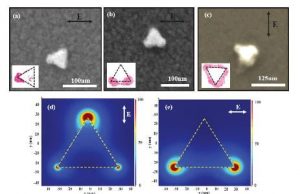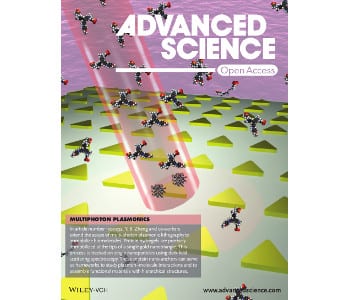 Understanding molecule–plasmon interactions has become increasingly important in recent years for various applications, such as single-molecule sensing, bio-imaging, and drug delivery. Crucial to this is the ability to precisely control localization of targeted biomolecules on the plasmonic nanoparticles. Researchers from Texas, USA, and Spain, used the technique multiphoton plasmonic lithography (MPPL) to achieve immobilization of bovine serum albumin hydrogels on a single gold nanotriangle (AuNT).
Understanding molecule–plasmon interactions has become increasingly important in recent years for various applications, such as single-molecule sensing, bio-imaging, and drug delivery. Crucial to this is the ability to precisely control localization of targeted biomolecules on the plasmonic nanoparticles. Researchers from Texas, USA, and Spain, used the technique multiphoton plasmonic lithography (MPPL) to achieve immobilization of bovine serum albumin hydrogels on a single gold nanotriangle (AuNT).
The interaction of incident electromagnetic radiation with metallic nanoparticles results in collective electron oscillations, known as localized surface plasmon resonances (LSPRs). This interaction allows light fields to be concentrated with significant enhancement at visible and near infrared wavelengths to the subwavelength scale. This, in turn, can be applied to improve efficiencies of phenomena such as surface-enhanced Raman spectroscopy, fluorescence and single-molecule detection. Advancing these applications toward immobilizing biomaterials, such as proteins, could enable nanoscale exploration of biological phenomena.
In this research, published in Advanced Science, the MPPL technique provided rapid immobilization of the bovine serum albumin hydrogels on the AuNT. With dark-field scattering spectroscopy and single electron microscopy, the sub-nanoparticle localization of the proteins with different configurations at the single AuNTs was tracked. These patterned proteins could be used as nano-anchors to precisely attach the AuNTs to cells for plasmon-enhanced imaging and photothermal therapy or to hold therapeutic agents in drug delivery, as well as acting as a framework for understanding light–molecule interactions at the subnanoparticle level.
Advanced Science is a new journal from the team behind Advanced Materials, Advanced Functional Materials, and Small. The journal is fully Open Access and is free to read now at www.advancedscience.com.

















